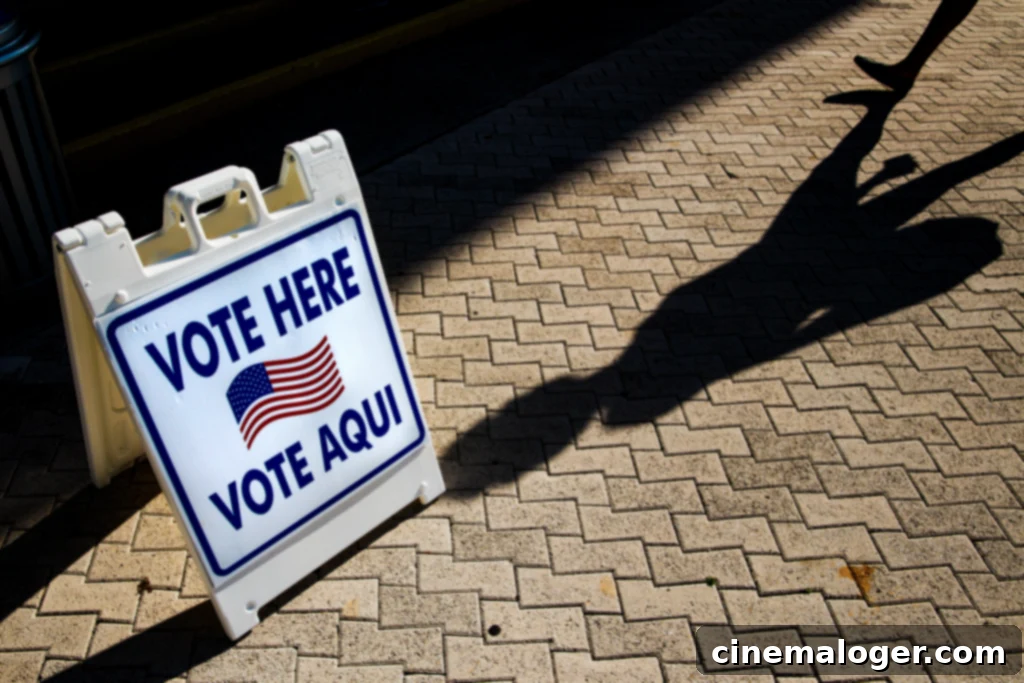Election Day 2024: Your Complete Guide to Voting and Understanding the Presidential Race
As Tuesday, November 5, approaches, the eyes of the nation turn to Election Day 2024. This pivotal moment will see citizens across the United States cast their ballots in a presidential race that promises to be closely watched. With the contest heating up between Vice President Kamala Harris and former President Donald Trump, every vote counts. Ensuring your participation is crucial to the democratic process. This comprehensive guide provides everything you need to know to confidently cast your vote, from confirming your registration to understanding how ballot counting unfolds and the current political landscape.
How to Verify Your Voter Registration Status
One of the most fundamental steps in preparing for Election Day is confirming your voter registration status. If you’ve participated in previous elections, you generally won’t need to re-register annually. However, it is absolutely essential to update your registration if there have been any changes to your name, residential address, or political party affiliation. These changes can impact your assigned polling location and ensure you receive the correct ballot. Even if you believe your information is current, a quick check can provide peace of mind and prevent any last-minute complications at the polls.
Each state maintains its own voter registration database and sets specific deadlines for updates or re-registration. To find your state’s particular requirements and verify your information, the most reliable resource is your respective Board of Elections website. These official portals offer comprehensive details on deadlines, acceptable forms of identification, and the process for updating your voter record. Some states also offer same-day voter registration, allowing you to register and vote on Election Day itself, but this is not universal and should be confirmed in advance for your specific state.
Locating Your Designated Polling Place
Once you’ve confirmed your registration, the next vital step is identifying your correct polling place. Polling locations are typically public buildings that are easily accessible, such as schools, community centers, churches, or various municipal buildings. These locations are strictly determined by your residential address and electoral district. It’s crucial to vote at your assigned polling place, as ballots are specific to your district, containing the correct local, state, and federal races for your area.
To pinpoint your designated polling location, you have several reliable avenues. Your state or county election office website is always an excellent starting point. Additionally, non-partisan organizations like Vote.org and the U.S. Election Assistance Commission website provide user-friendly tools where you can input your address and quickly find your polling site. It’s advisable to check this information a few days before Election Day to familiarize yourself with the location and plan your travel, ensuring a smooth voting experience.

When heading to the polls, remember that some states require voters to present identification. Voter ID laws vary significantly from state to state, ranging from requiring a photo ID to no ID at all, or allowing non-photo IDs. It’s best to check your state’s specific requirements before you go. Even if not strictly required, bringing a form of identification or your voter registration card can expedite the check-in process and resolve any potential issues efficiently. Poll workers are there to assist you, but being prepared ensures a quicker, hassle-free experience.
Understanding Different Voting Methods
Voters in the United States have access to several methods for casting their ballot, designed to offer flexibility and convenience. These generally include early in-person voting, absentee voting (often by mail), and traditional Election Day in-person voting. Understanding these options can help you choose the method that best suits your needs and schedule.
Early in-person voting allows registered voters to cast their ballot at designated locations before Election Day, often starting several weeks prior. This option is popular for those who wish to avoid potential crowds on Election Day or have scheduling conflicts. Absentee voting, frequently done by mail, permits voters to receive their ballot through the postal service and return it before a specific deadline. While some states offer “no-excuse” absentee voting, meaning anyone can request a mail-in ballot, others require a valid reason, such as illness or absence from the county. Finally, Election Day in-person voting is the traditional method, where voters visit their assigned polling place on November 5th to cast their ballot.
How to Check the Status of Your Ballot
With nearly 78 million people having already cast their votes through early or mail-in methods, many voters understandably want to confirm that their ballot has been received and counted. Fortunately, most states provide online tools for this very purpose. In all states except Illinois, Missouri, and Wyoming, voters can check the status of their ballots online, offering peace of mind and transparency in the election process.
For those who voted using a mail-in or absentee ballot, many states offer dedicated online databases. Citizens can typically input personal information, such as their name, date of birth, and zip code, to track their ballot’s journey from submission to being officially counted. This system helps ensure accountability and allows voters to verify their participation. If you encounter any issues or your ballot status is unclear, it’s advisable to contact your local election office immediately for clarification.
You can click on the links for the 47 states plus D.C. below to check the status of your mail-in ballot and confirm it has been counted:
Alabama, Alaska, Arizona, Arkansas, California, Colorado, Connecticut, Delaware, District of Columbia, Florida, Georgia, Hawaii, Idaho, Indiana, Iowa, Kansas, Kentucky, Louisiana, Maine, Maryland, Massachusetts, Michigan, Minnesota, Mississippi, Montana, Nebraska, Nevada, New Hampshire, New Jersey, New Mexico, New York, North Carolina, North Dakota, Ohio, Oklahoma, Oregon, Pennsylvania, Rhode Island, South Carolina, South Dakota, Tennessee, Texas, Utah, Vermont, Virginia, Washington, West Virginia, and Wisconsin.
In some cases, if there is a discrepancy in your registration or if you do not have the required ID, you may be offered a provisional ballot. This ballot allows you to cast your vote, which will then be counted once your eligibility is confirmed by election officials. It’s an important safeguard to ensure all eligible citizens have their voices heard, even when minor issues arise at the polls.
When to Expect Election Results
While Election Day culminates on Tuesday, November 5, the final tallies across states will often come in at different paces. Due to the anticipated tightness of the presidential race, the counting process could extend well past Election Night, possibly for several days. Various factors contribute to these delays, including the volume of mail-in and absentee ballots, state laws regarding when ballot counting can begin, and the need to process provisional ballots.
Mail-in ballots, for instance, often require more time to process and verify than in-person votes. Some states do not begin counting these ballots until Election Day itself, which can significantly prolong the tabulation process. The 2020 presidential election serves as a notable precedent, where it took until Saturday, November 7 – four days after Election Day – for major news networks to project a winner. This year, with a highly contested race, similar patience may be required as officials diligently work to ensure every legitimate vote is counted accurately.
It’s also important to remember that media outlets project winners based on incoming data, but official results are not certified until much later by state election authorities, often weeks after Election Day. Close races can also trigger automatic recounts in some states, further extending the timeline before definitive results are announced.
Who’s Ahead in the Polls? A Look at Battleground States
The 2024 presidential election is characterized by an extremely tight race, particularly across seven key battleground states: Arizona, Georgia, Michigan, Nevada, North Carolina, Pennsylvania, and Wisconsin. These states, often referred to as “swing states,” are critical because their electoral votes are not consistently aligned with one party, making them decisive in determining the outcome of the presidential election. Both candidates, Donald Trump and Kamala Harris, are actively campaigning in these regions, with poll numbers frequently alternating their lead based on the latest surveys and voter sentiment.
Recent polling data provides a snapshot of the current dynamics. A New York Times/Siena poll, released on the Sunday preceding Election Day, indicated Kamala Harris pulling ahead of Donald Trump in North Carolina and Wisconsin, two traditionally hard-fought states. Conversely, Trump continued to hold a lead in Arizona. In Pennsylvania, another crucial battleground, the candidates were effectively tied, each reportedly garnering 48 percent of the vote according to the same poll. These numbers highlight the volatility and competitiveness of the race, underscoring why every single vote in these states is immensely significant.
It’s crucial to interpret polls as indicators rather than definitive predictions. Polling data represents a moment in time and is subject to margins of error, varying methodologies, and shifts in public opinion as Election Day draws closer. The outcome will ultimately be decided by voter turnout and the final choices made in the ballot booth across these pivotal states.
Protecting Your Voter Rights and Seeking Assistance
Every eligible citizen has the right to cast a vote free from intimidation or undue interference. If you encounter any issues at your polling place, such as your name not appearing on the voter roll, being told you’re at the wrong precinct, or experiencing any form of harassment, know that you have rights and resources available. Do not hesitate to speak with a poll worker or an election official at your site. They are trained to resolve common issues and ensure a fair voting process.
Additionally, non-partisan organizations like the Election Protection coalition operate national hotlines (often 866-OUR-VOTE) where you can report problems and receive immediate assistance. These hotlines provide legal guidance and connect voters with advocates who can help ensure their vote is counted. Remember, your voice matters, and you are entitled to exercise your democratic right without obstruction.
The Undeniable Importance of Your Vote
Election Day is more than just a date on the calendar; it’s a fundamental pillar of democracy. Each vote cast contributes to shaping the future of the nation, influencing policies on everything from the economy and healthcare to education and environmental protection. Your participation, whether it’s for the presidential race or local initiatives, sends a powerful message about civic engagement and accountability.
In a race as close as the one anticipated between Vice President Harris and former President Trump, the impact of individual votes is amplified. Historical elections have often been decided by slim margins, demonstrating that every ballot truly has the potential to sway the outcome. By ensuring you are registered, know your polling place, and understand the voting process, you actively contribute to the democratic fabric of the United States. Make your voice heard on Tuesday, November 5, 2024.
